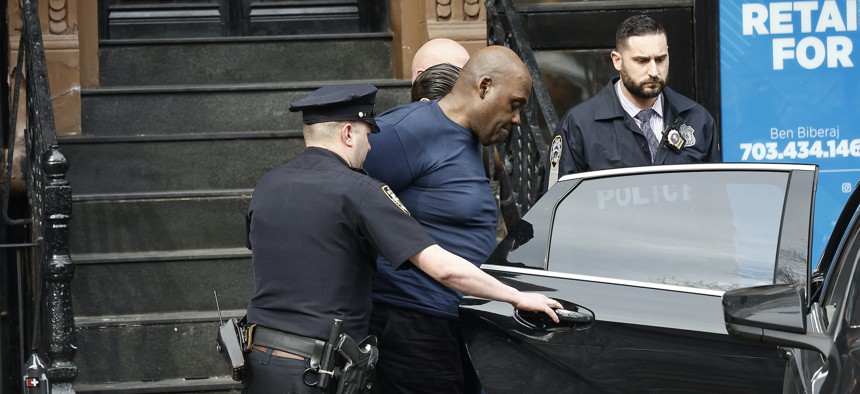New York City
ATF’s role in mass shooting suspect’s arrest highlights how agency helps NYC in war on guns
Mayor Eric Adams reiterated the importance of the NYPD’s partnership with the agency in the wake of last week’s Brooklyn subway shooting.

The NYPD arresting Frank James, the suspect in the subway shooting. John Lamparski/Getty Images
As mass shooting suspect Frank James wandered the streets of New York City after allegedly firing off 33 rounds inside a Brooklyn subway car last Tuesday morning, injuring more than two dozen people, the New York City Police Department was working hand-in-hand with its federal partners to help identify the shooter and track his whereabouts. Instrumental in that effort was the Bureau of Alcohol, Tobacco, Firearms and Explosives – which traced the serial number from the Glock 17 9mm handgun that police said James left at the scene to a pawn shop in Columbus, Ohio. The trace was used to confirm James’ identity, which was then released to the public. He was arrested hours after police officially named him a suspect.
The ATF’s strategic role in the case comes as local officials have expressed support for President Biden’s nomination of a permanent director to lead the ATF, former U.S. Attorney Steve Dettelbach. Biden has also called on Congress to ban the sale and possession of so-called “ghost guns,” along with other measures to stop them from being used in the commission of crimes. Ghost guns are made without serial numbers, making them near-impossible to trace.
“Mr. James was apprehended in under 30 hours because of the collaboration between our city, state, and federal partners, as well as the help of New Yorkers across the city,” Mayor Eric Adams said in a statement to City & State. “In order to do their part in damming the rivers that feed the sea of gun violence, the ATF needs a permanent director and Congress should immediately turn their attention to confirming this critical nominee.”“At the same time,” Adams added, “the Biden administration deserves real credit for taking strong steps to tackle the problem of ghost guns — the type of gun that was responsible for the tragic death of a 16-year-old child in the Bronx last week. Untraceable ghost guns are just as deadly as any other firearm, and they should be treated as such.”
The mayor noted that the NYPD has taken nearly 1,800 guns off the street in 2022 alone, “yet the guns just keep flowing into our city – leaving a trail of death and destruction in their wake.”
Adams noted that the city needs to continue its “strong collaboration with the ATF and other federal and state partners, so we can get the guns off our streets and reduce the tide of gun violence we’re seeing.” On Sunday he reiterated his stance on the importance of the ATF’s role in fighting gun crimes locally, telling ABC's George Stephanopoulos that there are only 80 ATF agents in New York out of 2,400 across the country.
David Chipman, former ATF special agent and senior policy director at the Giffords Law Center to Prevent Gun Violence, explained that few guns are as easily traceable as the one James allegedly left at the Sunset Park subway station. “This was the rare case that the trace was the smoking gun, it was in the guy’s name. That was almost like a TV crime. It doesn’t usually work out that way,” Chipman said, noting that guns used in crimes are often sold through a third-party in order to make them harder to trace.
And not all police departments have partnerships with the ATF – a circumstance that hinders the ability of the agency and the localities it works with since there is no cohesive system of national coordination when tracking down illegal firearms that crossed state lines, Chipman said.
“Some cities across the country don't trace any of their guns. New York benefits from ATF being stronger and more robust across the entire country,” Chipman said. “You want more agents with ATF in Virginia. You want them in Georgia, you want them in Florida. You want them in Ohio. You want them in all these states that fuel the violence . . . you guys are spoiled in New York.”
In addition to helping the NYPD solve crimes, the ATF has mechanisms for taking illegal guns off the street before they’re used to hurt or kill people, Chipman explained, though it’s a greater challenge than investigating gun crimes that have already occurred. “I always felt frustrated, because ATF in my mind sort of stood for ‘After The Fact,’” Chipman said, adding that to prevent crimes, “the primary way ATF does that is to develop information through informants.”
Despite having a criminal record, James was able to purchase a gun legally in Ohio in 2011, authorities said. Ohio is one of the top seven states where guns used in the commission of crimes in New York are traced to, according to a 2016 report by state Attorney General Letitia James’ office. It’s the only state that is part of the “Iron Pipeline” that is not linked to I-95, the highway that runs from the Canadian border to the tip of Florida and is used as a trafficking route for illegal guns flowing north from southern states with looser restrictions.
“Ohio shares characteristics with the traditional Iron Pipeline states in that it has weak gun safety laws and has easy access to New York via interstate highway,” the report states. “For this reason and since it contributes 3% of all guns and 4% of handguns, we include it in the New York Pipeline.”

